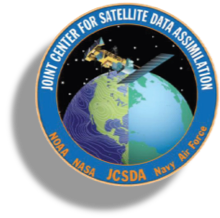JCSDA is pleased to announce the release of Skylab 8.0!
JCSDA SkyLab 8.0 is the eighth roll-up release that provides integrated Earth System Data Assimilation capability. All JEDI code is open source and publicly available at https://github.com/JCSDA. Capabilities are demonstrated via the SkyLab testbed experiments conducted internally at JCSDA for the following components: atmosphere, land/snow, ocean, sea-ice, aerosols, and atmospheric composition. SkyLab testbed output plots are openly available through the SkyLab Data Viewer at https://skylab.jcsda.org.
The main upgrades for this release include:
skylab-weather-land-8_0 experiment:
We added two exciting new features: visible reflectance simulation, and surface soil moisture. The visible reflectance is from the Advanced Baseline Imager (ABI) on GOES 16-18, and is the first demonstration of visible reflectance assimilation using the CRTM. The use of visible reflectance observations is a significant advancement enabled by CRTM 3.1.0. The soil moisture product is produced from the NASA sensor, SMAP.
skylab-weather-variable-grid-8_0 experiment:
The addition of multi-radar multi-sensor (MRMS) ground-based radar incorporates samples from the very dense data stream of CONUS radar reflectivity information. It is demonstrated with the JEDI-MPAS interface with radar data exclusively over CONUS.
skylab-marine-8_0 experiment:
We have been cleaning out old, no-longer used code and increasing the efficiency and ease of maintenance of the main SOCA code base. We've removed almost 4,000 lines of code this quarter without changing the marine SkyLab experiment, deleted the non-coupled ocean model and its interface since it’s of limited scientific value, and decreased the number of code lines back to 2022 levels without changing any of SkyLab’s functionality.
skylab-aerosol-weather-8_0 experiment:
The SkyLab 4DEnVar aero-weather v8 now uses CRTM AOD using NASA LUTs for aerosol providing more consistent optical properties with the GEOS model for aerosol assimilation. This change has been possible with the AOD (Aerosol Optical Depth) CRTM UFO interface which is now much more generic. It allows users to bring in their aerosol look-up tables for experiments.
skylab-trace-gas-7_0 experiment:
In this release, we added 4DEnVar capability for the trace gas experiment and improved the NICAS/BUMP horizontal localization for atmospheric composition, which will provide better increments at different atmospheric levels.
Software infrastructure
Environment to build: all libraries on SPACK-STACK 1.7.0
Tested for the following system requirements:
Amazon Web Services (AWS) Single Node AMI (RedHat 8; gnu)
NASA Discover (gnu & intel)
NOAA Mississippi State University Orion (gnu & intel)
NOAA Mississippi State University Hercules (gnu & intel)
NOAA University of Wisconsin S4 (intel)
Limited support for NCAR-Wyoming Derecho (gnu & intel)
Limited support for NOAA ParallelWorks AWS, Azure, Gcloud (intel)
SkyLab has been developed by the JCSDA with contributions from its Partner Agencies in NOAA, NASA, the US Air Force, and the US Navy.
To read more about the release, links to the code, release notes and tutorials, visit www.jcsda.org/jediskylab .
Photo by NOAA on Unsplash

